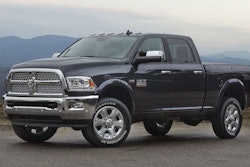This is Part 3 of a five-part series on used equipment. Click here to see the other parts of the series. Click here to download the full version of the Used Equipment Report.
Now that you’ve picked out that used excavator or wheel loader to add to your fleet, the next step to figure out is how to finance it.
Thanks to dealers selling their rental machines, leases ending and trade-ins arriving, there’s plenty of supply for high-quality, late-model equipment on the market, lenders say. They also indicate there’s plenty of credit available to help make those deals.
Borrowing money to buy used construction equipment, however, may take some shopping around to find the deal that best fits your needs. Lenders say just looking for the lowest interest rate might not make the most long-term financial sense.
“It’s not like financing a new car or a used car,” says John Crum, senior vice president at Wells Fargo Equipment Finance. “There are so many things that are a factor in buying or financing a used piece of construction equipment.”
Get to know the machine
One of the first things lenders will want to know is the age of the equipment you’re buying, what condition it’s in and who owned it before you.
Because equipment doesn’t have registered titles like cars and trucks, buying used machinery can take lots of homework to make sure there’s clear title to the machine and no liens against it. That’s especially true in contractor-to-contractor sales and when equipment has changed hands several times over the years. The lender will want to see all the bills of sale or proof of ownership from the original sale forward.
“It can get complicated, time-consuming and costly to do that if you’re doing multiple lien searches,” Crum says. “It can be a long and frustrating process for the buyer and the seller.”
One way to prevent such lengthy searching is to purchase from a franchise dealer, he says. The dealers generally have already done the title work.
Along with determining the machine’s pedigree, lenders will want to research its value. Be prepared to discover that the price you’re paying may not match the lender’s loan value.
Lenders typically look at what similar machines bring at auction or average resale. With that dollar figure determined, they can then decide how much money they’re willing to lend.
But that’s just part of the loan picture. The other pieces to the loan puzzle focus on the borrower.
There’s an application for that
Most lenders, be they banks or equipment manufacturers’ financial services, will require you to fill out an application to borrow money. And in many cases, if you’ve got good credit and are buying a late-model, low-hour machine, that’s all they’ll need.
They’ll research your credit history and credit references, and then structure the loan terms based on that information and the value of the machine.
The process becomes a little more complicated for older machinery or if the borrower has some credit problems.
Then, the lender may seek financial statements from previous years. They may also ask to see your company’s work history, documentation of current projects and any contracts for future work.
The top reason for denying a loan, lenders say, is poor repayment history. But many lenders are willing to seek ways to overcome credit hurdles. That’s particularly true for financial services divisions of the major equipment manufacturers. A large part of their mission is to help their dealers serve customers.
“That means that we approve a high percentage of the deals that come to us because we try to fulfill that mission, while at the same time, we manage the risk that’s associated with lending,” says Dave Gilmore, senior vice president of global marketing and sales for John Deere Financial. “We’ll look for a way to say yes to the deal through different structures of the loan that match customer repayment capabilities.”
The best of terms
Now that the equipment and your credit have been considered, it’s time to structure the terms of the financing.
Questions like how long will it take you to pay back the loan, how much will it cost you to borrow the money and how much money will you have to put down come into play. This can be the most complicated – and costly – part of the deal and where lenders say it’s important to not just consider interest rates.
“Decision-makers often want to focus on rate,” says Mike Rankin, vice president construction equipment financial services for Volvo Financial Services. “But you really have to look at prepayment charges, fees, loan terms and the flexibility of the lender to work with you.”
The usual financing for used equipment is a fixed-rate loan for 24 to 48 months. Some lenders are also offering terms up to 60 months for late-model rental-equipment purchases.
Interest rates on used equipment tend to range from 1 to 5 percent. Some manufacturers are offering zero-interest loans for their dealers’ sales of trade-ins and lease returns. They’re also offering warranties and maintenance deals as incentives on some used equipment.
Lenders say the loans typically come with down payments, but some loans do not require them. Down payments usually range from 10 to 20 percent. The amount of the down payment often depends upon the borrower’s credit history and the machine’s value.
Those with less than stellar credit may have to make concessions to get financing. That might require accelerating the loan payments to gain equity faster. They might also have to accept a shorter repayment time and put up more collateral or a higher down payment.
Collateral is usually the purchased equipment itself. Other collateral can also be offered, such as real estate, but real estate will require attorney fees, which can be costly.
Those who want to avoid a down payment might consider leasing. That option usually only makes sense for newer machines coming off a rental fleet. Customers can lease the equipment for the length of a project or as long as they need it. Lenders say, though, that loans are still the most typical financing for used equipment.
Another concern for borrowers: What happens if the economy turns south?
Some lenders say they will help borrowers refinance when they are facing tough economic times and also take into account that used equipment is often an entry-level purchase for startup businesses.
“We understand the ups and downs of the construction industry and look for a way to get approval, even if they have a somewhat bumpy history,” says Rich Fikis, president of Komatsu Finance. “We often assist in cyclical times to keep them as a long-term customer.”
A good time to borrow
Lenders say that for the past five years, they’ve seen a steady increase in borrowing for used equipment.
They attribute it to the economic health of their customers and a large supply of late-model equipment up for sale.
“It is a good time for customers to look at used equipment because there’s a good supply of it,” says Rankin, of Volvo Financial Services. “It’s generally late-model stuff, with low to moderate hours on it. Pricewise they can get some pretty attractive payments and pricing.”
And with the larger supply comes lots of lenders seeking your business.
“It’s extremely competitive,” Rankin adds. “There are a lot of lenders out there chasing the business.”
Download the entire Used Equipment Report
Part 1: Regional demands drive used prices
Part 2: Buying? Selling? Here are some contractor-honed strategies
Part 3: Lenders — Plenty of credit available for used-equipment buyers
Part 4: Used vocational trucks may not remain a buyer’s market for long
Part 5: How does the No. 1 rental firm dispose of its equipment?



















